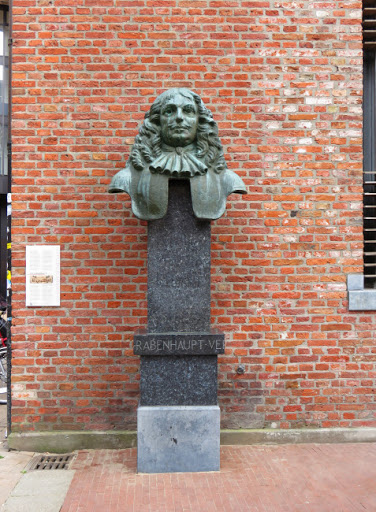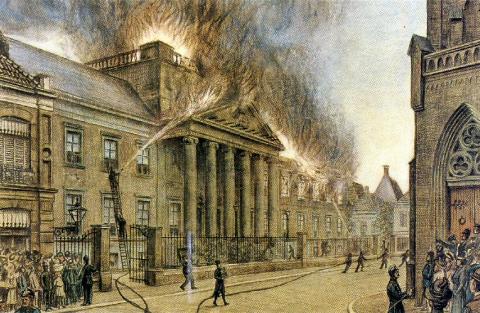4 Historical Challenges the UG Overcame

In its long and illustrious history, Groningen has faced numerous challenges. From being besieged by ‘Bommen Berend’ to the Spanish Flu and World War 2, the city and its university have seen it all. But no matter how difficult the situation, Groningers have always stood together even through the toughest of times. For this blog, I have gathered some of the largest historical challenges that the city has faced throughout its 1000-year-old existence - and how the city's population and students overcame these adversities.
1. Groningens Ontzet (The Siege of Groningen)
In 1672 Bernhard von Galen, who was the Bishop of Münster at that time, saw an opportunity to expand his territory amidst the chaotic circumstances the newly born Republic of the Netherlands found itself in. Better known as ‘Bommen Berend’ (Bombing Berend) due to his extensive use of canons, the Bishop besieged Groningen for a month. During this time, all 120 students from the UG formed a voluntary student company which stood at the frontlines standing guard to protect the city. Groningen’s victory, which is partly due to the bravery of the UG students, is still commemorated every year on the 28th of August with a large firework show and festivities throughout the city. Carl von Rabenhaupt, a general who played an important role during the siege, is even honoured with a statue. Can you spot where in the city it stands?

2. The Groningen Epidemic
In 1826 a mysterious disease struck Groningen. Costing the lives of nearly 10% of the city's population, the illness came to be known as the ‘Groningen epidemic’ as its spread was limited only to Groningen and some areas in Friesland. While some researchers speculate that the disease was a malaria epidemic caused by broken dykes and hot weather, others claim it to be a combination of typhus and other illnesses. While the exact cause remains uncertain, the epidemic caused the city to come to a standstill. The university had to be closed for months, and the churches were even prohibited from sounding their bells during funerals to not discourage the population. During the outbreak, medical students and professors from the university helped to combat the disease. Eventually, new rules regulating where to bury people and the use of chlorine in the canals of the city helped mitigate the fallout. By December 1826, studies could resume normally and life in Groningen returned to its normal pace.
3. The Academy Building Fire
During the renovation of the Academy building facade in 1906, a devastating fire broke out which burned down the entire building. Initially caused by painters who were burning off old paint, the fire ultimately got out of control when it reached the attic where many animal specimens were preserved in alcohol. Needless to say, concentrated alcohol and fire don’t mix well and the entire collection, as well as the building itself, were lost in the fire. Luckily, some historically important items were saved such as old portraits of professors and the banner of the voluntary student company of 1672. After the fire, lectures had to be moved to the AA Kerk and the university had to adapt its schedules. Impressively, plans for a new building were presented just a week later and construction was completed a mere 3 years afterwards. Once more, the UG made the best out of a bad situation and came out looking better more than ever.

4. World War 2
Following the occupation of the Netherlands by the Germans during world war two, the University of Groningen went through some dark years. Although the UG remained open for the duration of the war, the Germans aimed at assimilating the university to their national socialist ideology. This was done by installing ‘puppet headmasters’ and prohibiting Jewish students and professors from attending university. After a series of further measures in 1942 a protest started to form against the occupiers and students started to boycott lectures. As a response to this, the Germans demanded every student to sign a ‘declaration of loyalty’ in order to continue their studies without disruption. This plan backfired as only 10% of students signed this document, which ultimately led to a complete suspension of all education at the university. Some students of the university even went on to actively fight the Nazis, such as Anda Kerkhoven who was known to be an avid pacifist who joined a Dutch resistance group which solely focussed on non-violent acts of resistance. Ultimately, Anda Kerkhoven and the rest of her comrades were executed by Dutch Nazi collaborators for their roles in March 1945 which was shortly before Groningen’s liberation by the Canadians on the 18th April 1945. Today, various plaques and illustrations in the Academy Building commemorate the students and professors that fell victim to the Nazis during these times. Due to the bravery and unity of the academic community back then, the Nazi’s were never able to fully take control of the university and use it as a tool to spread their inhuman ideology.
As you can see, the city has faced many challenges in the past. From wars to diseases and unforeseen accidents, Groningen has been through a great deal over the course of time. Although some challenges lasted longer than others, they all have one thing in common: the determination of the city and the academic community to persist and pull through. Thanks to the initiative of everyone in the city, Groningen has always recovered from these challenges and came out stronger than before. This time around, we have to learn from past challenges and come together once more. By staying at home and doing our share to prevent the spread of the coronavirus we, the academic community, can once more demonstrate our willingness and determination to overcome this historical challenge together. I don’t have any doubts that we will succeed in doing so and come out better and stronger than before.

